Factors Affecting Consumer Behavior in the Tourism Sector Report
VerifiedAdded on 2022/12/13
|12
|4375
|93
Report
AI Summary
This report delves into the multifaceted realm of tourism consumer behavior, examining the various cultural, socioeconomic, personal, and psychological variables that shape customer attitudes and perceptions within the industry. It explores how emerging media influences market trends, analyzes the stages of consumer decision-making in relation to tourism services, and emphasizes the importance of marketers charting a route to purchase. The report further contrasts the hospitality decision-making process in B2C and B2B contexts, using specific tourism examples. It also considers market analysis techniques and research processes used to explain decision-making, and assesses how advertisers can influence the different phases of tourism decision-making, providing clear examples.
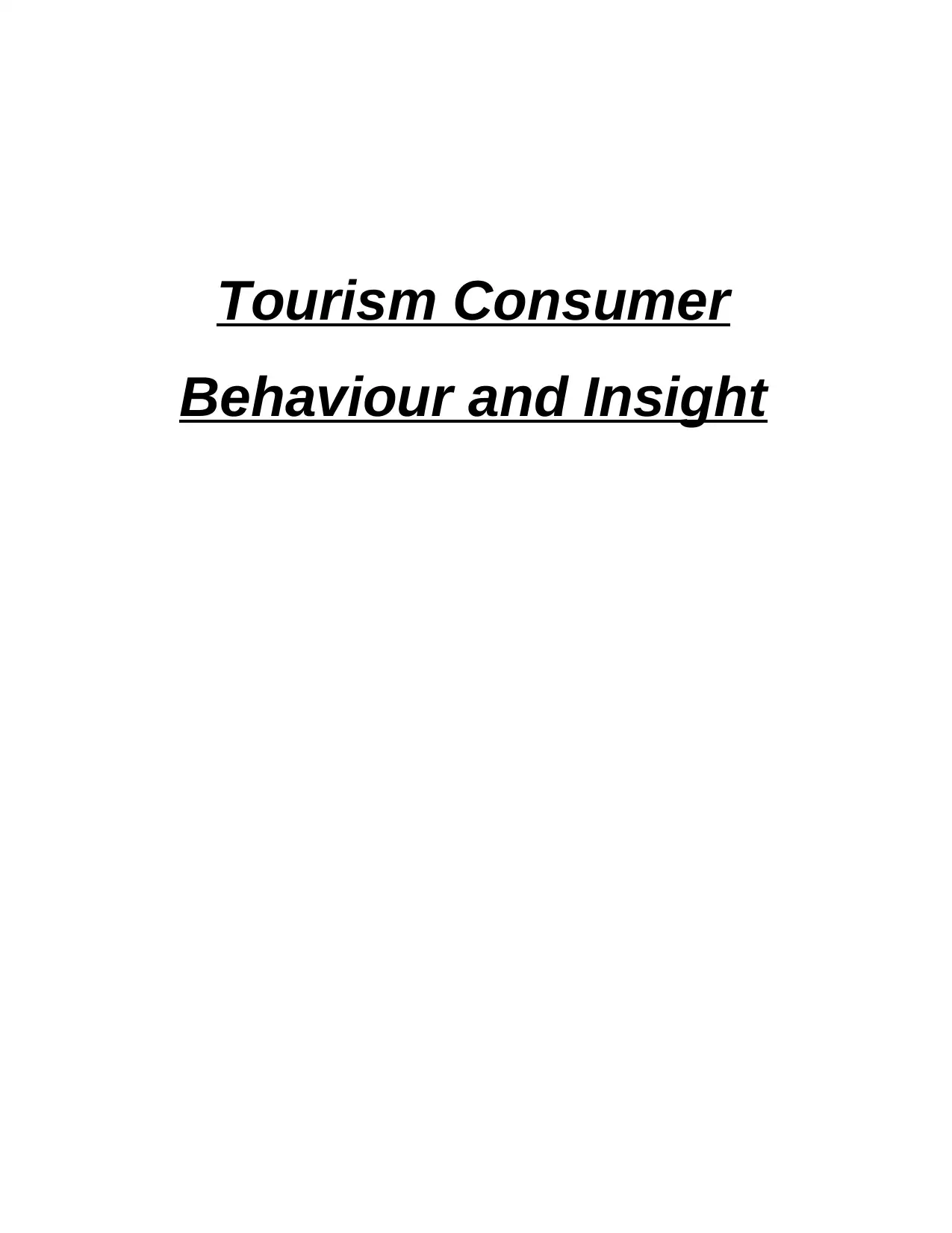
Tourism Consumer
Behaviour and Insight
Behaviour and Insight
Paraphrase This Document
Need a fresh take? Get an instant paraphrase of this document with our AI Paraphraser
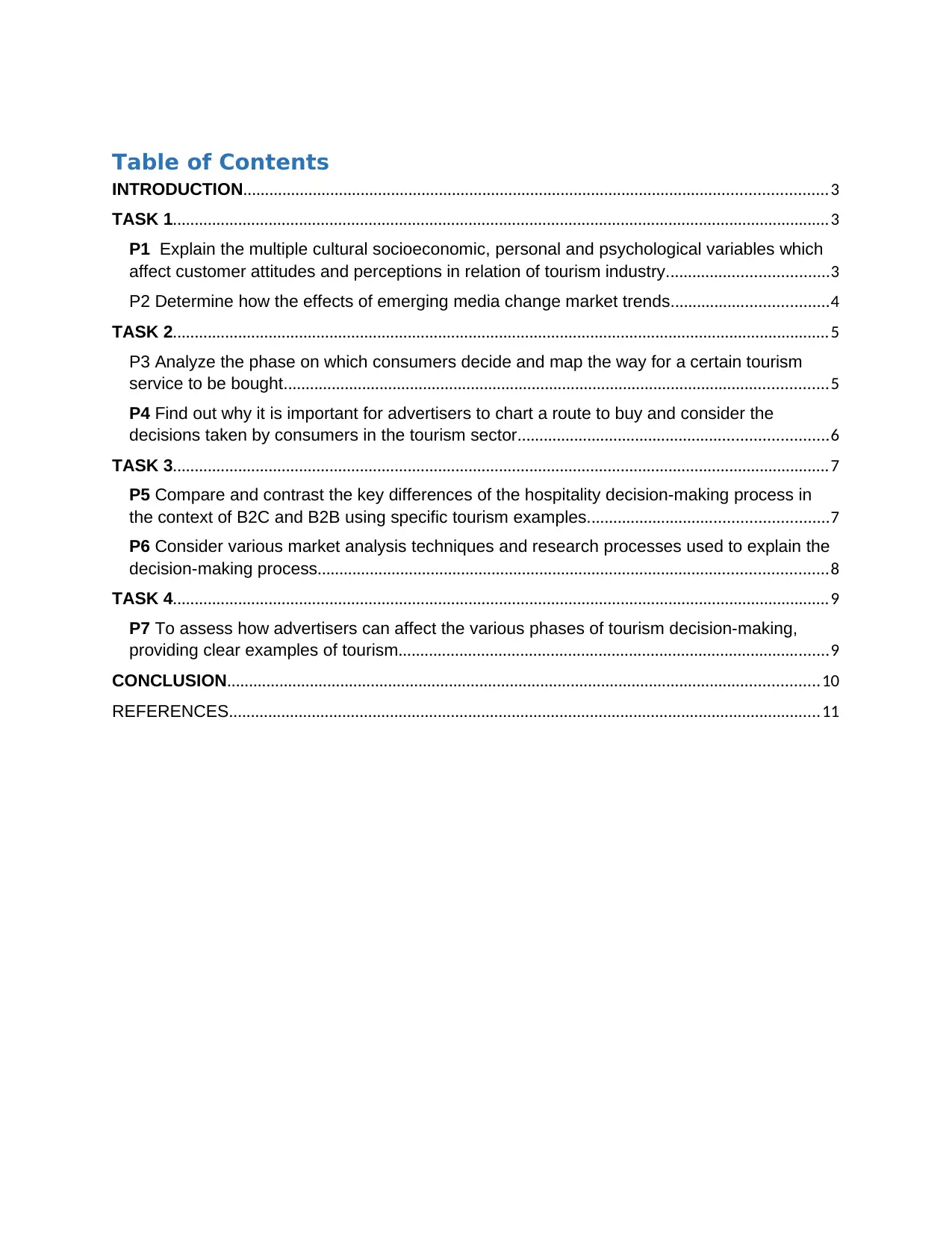
Table of Contents
INTRODUCTION......................................................................................................................................3
TASK 1.......................................................................................................................................................3
P1 Explain the multiple cultural socioeconomic, personal and psychological variables which
affect customer attitudes and perceptions in relation of tourism industry.....................................3
P2 Determine how the effects of emerging media change market trends....................................4
TASK 2.......................................................................................................................................................5
P3 Analyze the phase on which consumers decide and map the way for a certain tourism
service to be bought.............................................................................................................................5
P4 Find out why it is important for advertisers to chart a route to buy and consider the
decisions taken by consumers in the tourism sector.......................................................................6
TASK 3.......................................................................................................................................................7
P5 Compare and contrast the key differences of the hospitality decision-making process in
the context of B2C and B2B using specific tourism examples.......................................................7
P6 Consider various market analysis techniques and research processes used to explain the
decision-making process.....................................................................................................................8
TASK 4.......................................................................................................................................................9
P7 To assess how advertisers can affect the various phases of tourism decision-making,
providing clear examples of tourism...................................................................................................9
CONCLUSION........................................................................................................................................10
REFERENCES........................................................................................................................................11
INTRODUCTION......................................................................................................................................3
TASK 1.......................................................................................................................................................3
P1 Explain the multiple cultural socioeconomic, personal and psychological variables which
affect customer attitudes and perceptions in relation of tourism industry.....................................3
P2 Determine how the effects of emerging media change market trends....................................4
TASK 2.......................................................................................................................................................5
P3 Analyze the phase on which consumers decide and map the way for a certain tourism
service to be bought.............................................................................................................................5
P4 Find out why it is important for advertisers to chart a route to buy and consider the
decisions taken by consumers in the tourism sector.......................................................................6
TASK 3.......................................................................................................................................................7
P5 Compare and contrast the key differences of the hospitality decision-making process in
the context of B2C and B2B using specific tourism examples.......................................................7
P6 Consider various market analysis techniques and research processes used to explain the
decision-making process.....................................................................................................................8
TASK 4.......................................................................................................................................................9
P7 To assess how advertisers can affect the various phases of tourism decision-making,
providing clear examples of tourism...................................................................................................9
CONCLUSION........................................................................................................................................10
REFERENCES........................................................................................................................................11
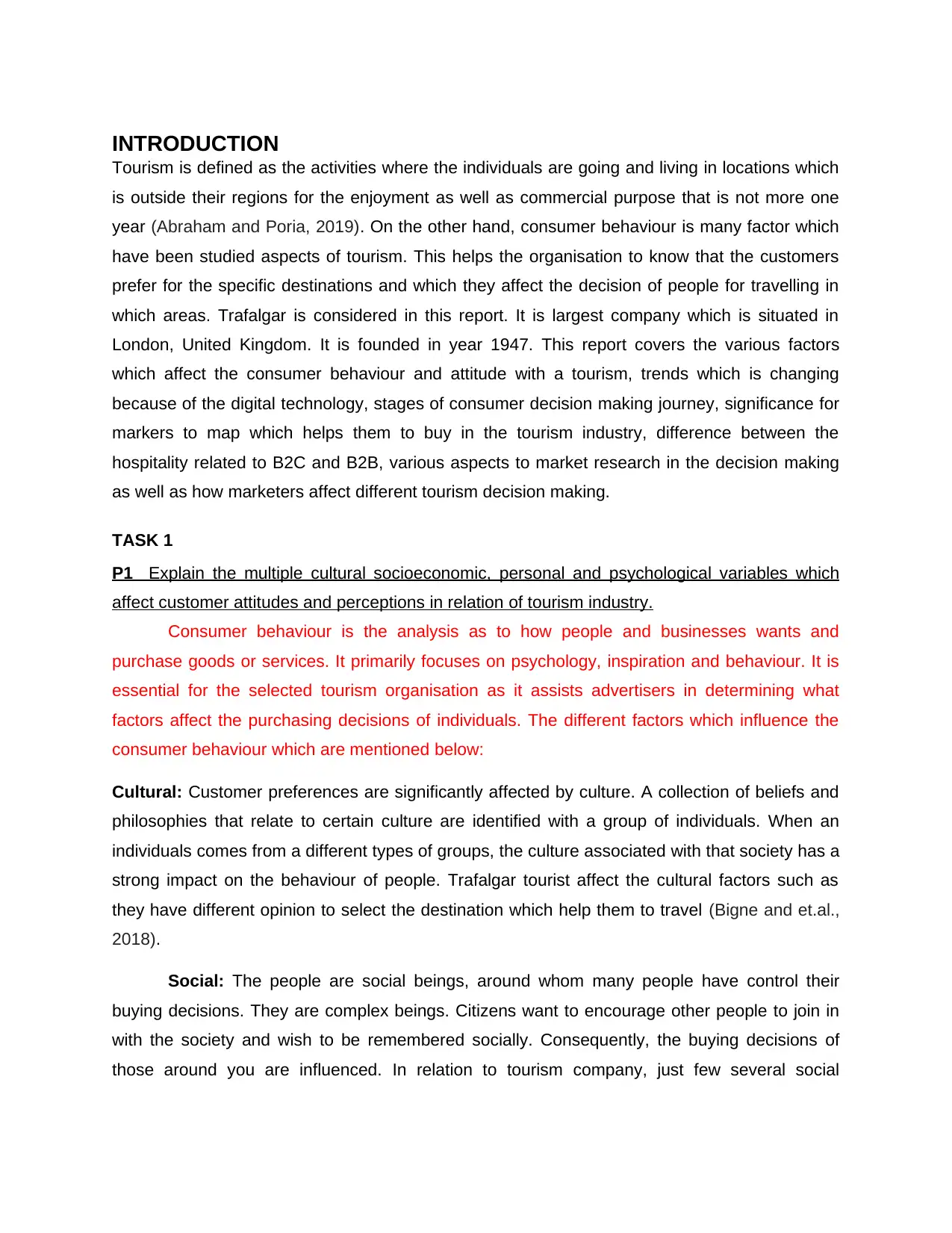
INTRODUCTION
Tourism is defined as the activities where the individuals are going and living in locations which
is outside their regions for the enjoyment as well as commercial purpose that is not more one
year (Abraham and Poria, 2019). On the other hand, consumer behaviour is many factor which
have been studied aspects of tourism. This helps the organisation to know that the customers
prefer for the specific destinations and which they affect the decision of people for travelling in
which areas. Trafalgar is considered in this report. It is largest company which is situated in
London, United Kingdom. It is founded in year 1947. This report covers the various factors
which affect the consumer behaviour and attitude with a tourism, trends which is changing
because of the digital technology, stages of consumer decision making journey, significance for
markers to map which helps them to buy in the tourism industry, difference between the
hospitality related to B2C and B2B, various aspects to market research in the decision making
as well as how marketers affect different tourism decision making.
TASK 1
P1 Explain the multiple cultural socioeconomic, personal and psychological variables which
affect customer attitudes and perceptions in relation of tourism industry.
Consumer behaviour is the analysis as to how people and businesses wants and
purchase goods or services. It primarily focuses on psychology, inspiration and behaviour. It is
essential for the selected tourism organisation as it assists advertisers in determining what
factors affect the purchasing decisions of individuals. The different factors which influence the
consumer behaviour which are mentioned below:
Cultural: Customer preferences are significantly affected by culture. A collection of beliefs and
philosophies that relate to certain culture are identified with a group of individuals. When an
individuals comes from a different types of groups, the culture associated with that society has a
strong impact on the behaviour of people. Trafalgar tourist affect the cultural factors such as
they have different opinion to select the destination which help them to travel (Bigne and et.al.,
2018).
Social: The people are social beings, around whom many people have control their
buying decisions. They are complex beings. Citizens want to encourage other people to join in
with the society and wish to be remembered socially. Consequently, the buying decisions of
those around you are influenced. In relation to tourism company, just few several social
Tourism is defined as the activities where the individuals are going and living in locations which
is outside their regions for the enjoyment as well as commercial purpose that is not more one
year (Abraham and Poria, 2019). On the other hand, consumer behaviour is many factor which
have been studied aspects of tourism. This helps the organisation to know that the customers
prefer for the specific destinations and which they affect the decision of people for travelling in
which areas. Trafalgar is considered in this report. It is largest company which is situated in
London, United Kingdom. It is founded in year 1947. This report covers the various factors
which affect the consumer behaviour and attitude with a tourism, trends which is changing
because of the digital technology, stages of consumer decision making journey, significance for
markers to map which helps them to buy in the tourism industry, difference between the
hospitality related to B2C and B2B, various aspects to market research in the decision making
as well as how marketers affect different tourism decision making.
TASK 1
P1 Explain the multiple cultural socioeconomic, personal and psychological variables which
affect customer attitudes and perceptions in relation of tourism industry.
Consumer behaviour is the analysis as to how people and businesses wants and
purchase goods or services. It primarily focuses on psychology, inspiration and behaviour. It is
essential for the selected tourism organisation as it assists advertisers in determining what
factors affect the purchasing decisions of individuals. The different factors which influence the
consumer behaviour which are mentioned below:
Cultural: Customer preferences are significantly affected by culture. A collection of beliefs and
philosophies that relate to certain culture are identified with a group of individuals. When an
individuals comes from a different types of groups, the culture associated with that society has a
strong impact on the behaviour of people. Trafalgar tourist affect the cultural factors such as
they have different opinion to select the destination which help them to travel (Bigne and et.al.,
2018).
Social: The people are social beings, around whom many people have control their
buying decisions. They are complex beings. Citizens want to encourage other people to join in
with the society and wish to be remembered socially. Consequently, the buying decisions of
those around you are influenced. In relation to tourism company, just few several social
⊘ This is a preview!⊘
Do you want full access?
Subscribe today to unlock all pages.

Trusted by 1+ million students worldwide
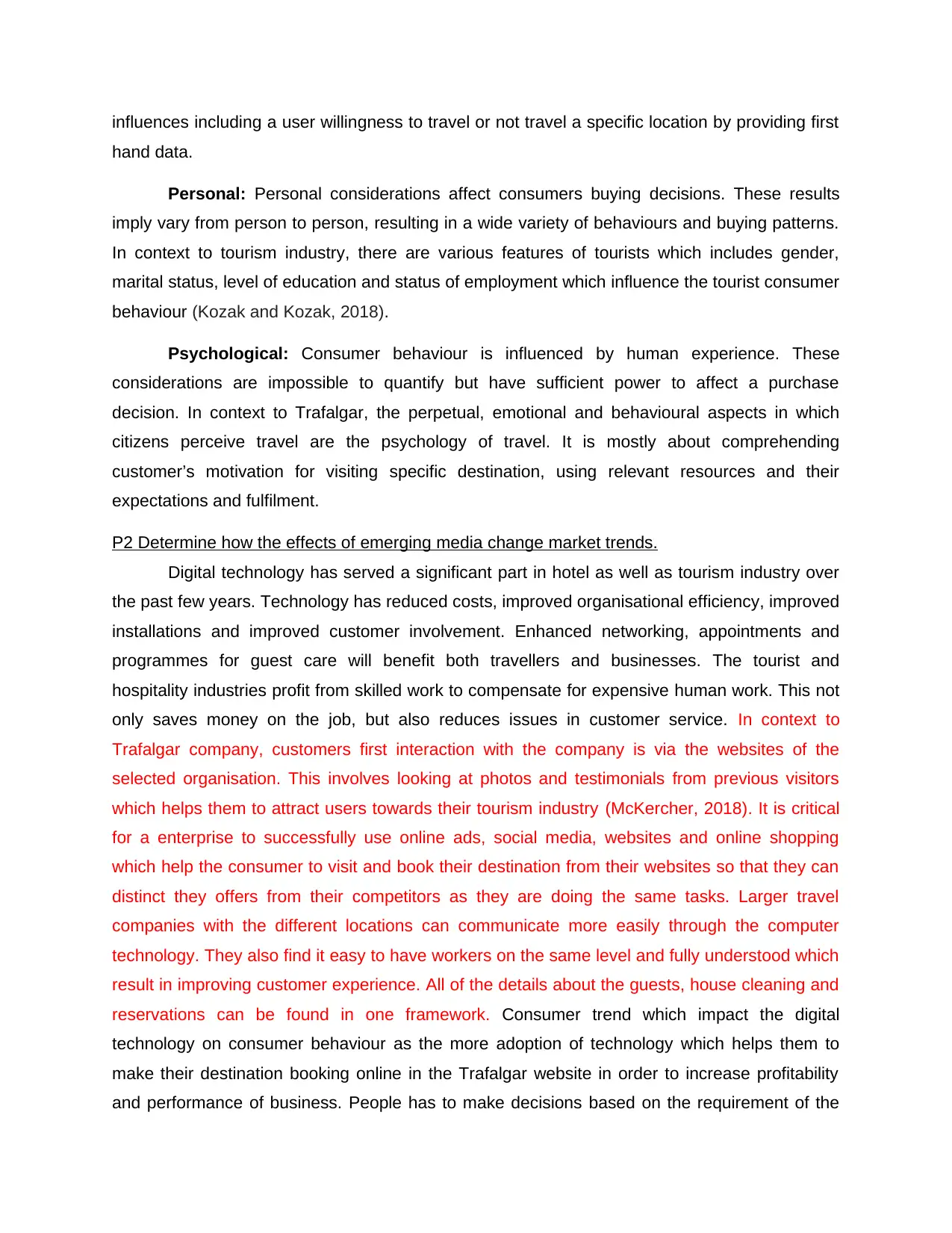
influences including a user willingness to travel or not travel a specific location by providing first
hand data.
Personal: Personal considerations affect consumers buying decisions. These results
imply vary from person to person, resulting in a wide variety of behaviours and buying patterns.
In context to tourism industry, there are various features of tourists which includes gender,
marital status, level of education and status of employment which influence the tourist consumer
behaviour (Kozak and Kozak, 2018).
Psychological: Consumer behaviour is influenced by human experience. These
considerations are impossible to quantify but have sufficient power to affect a purchase
decision. In context to Trafalgar, the perpetual, emotional and behavioural aspects in which
citizens perceive travel are the psychology of travel. It is mostly about comprehending
customer’s motivation for visiting specific destination, using relevant resources and their
expectations and fulfilment.
P2 Determine how the effects of emerging media change market trends.
Digital technology has served a significant part in hotel as well as tourism industry over
the past few years. Technology has reduced costs, improved organisational efficiency, improved
installations and improved customer involvement. Enhanced networking, appointments and
programmes for guest care will benefit both travellers and businesses. The tourist and
hospitality industries profit from skilled work to compensate for expensive human work. This not
only saves money on the job, but also reduces issues in customer service. In context to
Trafalgar company, customers first interaction with the company is via the websites of the
selected organisation. This involves looking at photos and testimonials from previous visitors
which helps them to attract users towards their tourism industry (McKercher, 2018). It is critical
for a enterprise to successfully use online ads, social media, websites and online shopping
which help the consumer to visit and book their destination from their websites so that they can
distinct they offers from their competitors as they are doing the same tasks. Larger travel
companies with the different locations can communicate more easily through the computer
technology. They also find it easy to have workers on the same level and fully understood which
result in improving customer experience. All of the details about the guests, house cleaning and
reservations can be found in one framework. Consumer trend which impact the digital
technology on consumer behaviour as the more adoption of technology which helps them to
make their destination booking online in the Trafalgar website in order to increase profitability
and performance of business. People has to make decisions based on the requirement of the
hand data.
Personal: Personal considerations affect consumers buying decisions. These results
imply vary from person to person, resulting in a wide variety of behaviours and buying patterns.
In context to tourism industry, there are various features of tourists which includes gender,
marital status, level of education and status of employment which influence the tourist consumer
behaviour (Kozak and Kozak, 2018).
Psychological: Consumer behaviour is influenced by human experience. These
considerations are impossible to quantify but have sufficient power to affect a purchase
decision. In context to Trafalgar, the perpetual, emotional and behavioural aspects in which
citizens perceive travel are the psychology of travel. It is mostly about comprehending
customer’s motivation for visiting specific destination, using relevant resources and their
expectations and fulfilment.
P2 Determine how the effects of emerging media change market trends.
Digital technology has served a significant part in hotel as well as tourism industry over
the past few years. Technology has reduced costs, improved organisational efficiency, improved
installations and improved customer involvement. Enhanced networking, appointments and
programmes for guest care will benefit both travellers and businesses. The tourist and
hospitality industries profit from skilled work to compensate for expensive human work. This not
only saves money on the job, but also reduces issues in customer service. In context to
Trafalgar company, customers first interaction with the company is via the websites of the
selected organisation. This involves looking at photos and testimonials from previous visitors
which helps them to attract users towards their tourism industry (McKercher, 2018). It is critical
for a enterprise to successfully use online ads, social media, websites and online shopping
which help the consumer to visit and book their destination from their websites so that they can
distinct they offers from their competitors as they are doing the same tasks. Larger travel
companies with the different locations can communicate more easily through the computer
technology. They also find it easy to have workers on the same level and fully understood which
result in improving customer experience. All of the details about the guests, house cleaning and
reservations can be found in one framework. Consumer trend which impact the digital
technology on consumer behaviour as the more adoption of technology which helps them to
make their destination booking online in the Trafalgar website in order to increase profitability
and performance of business. People has to make decisions based on the requirement of the
Paraphrase This Document
Need a fresh take? Get an instant paraphrase of this document with our AI Paraphraser
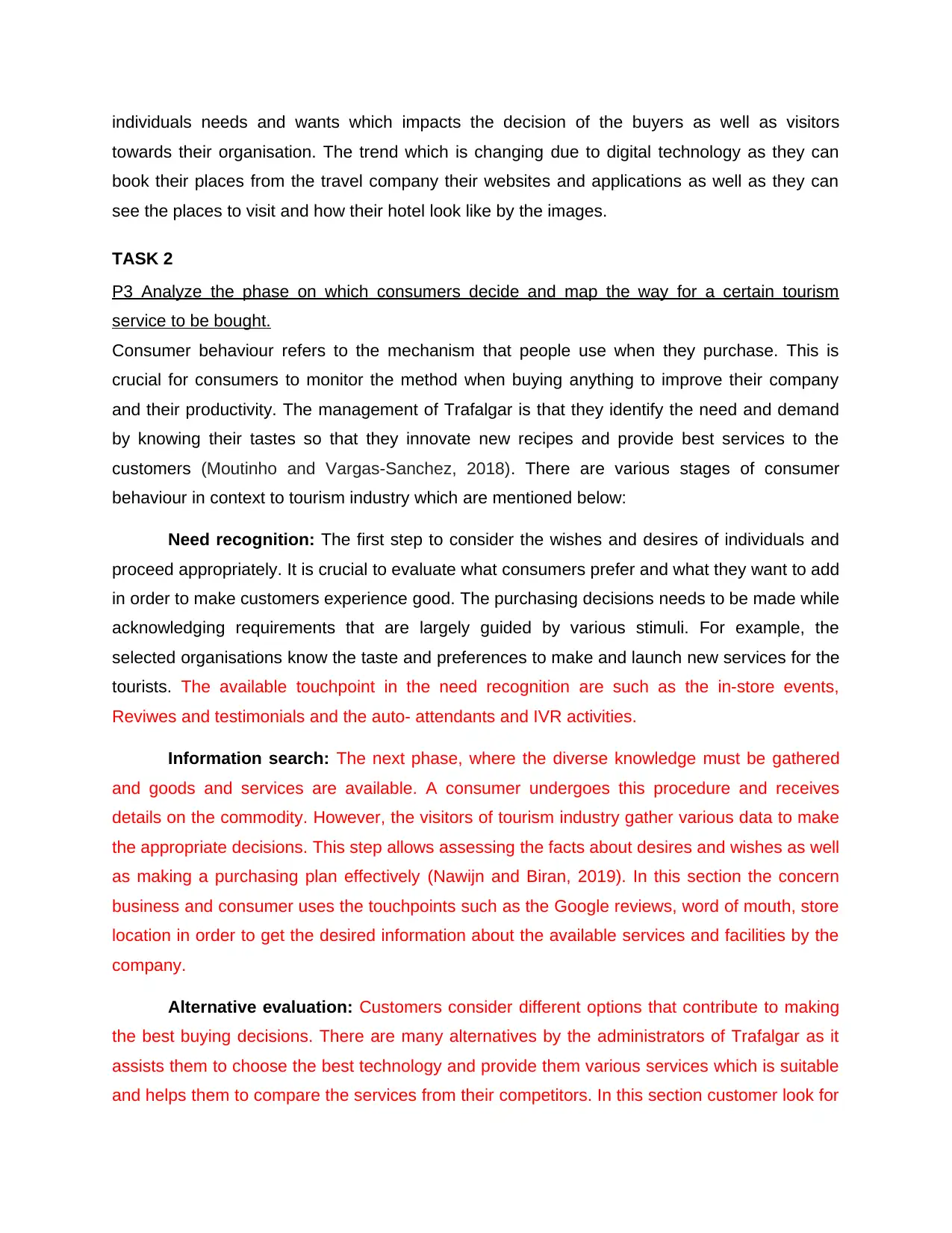
individuals needs and wants which impacts the decision of the buyers as well as visitors
towards their organisation. The trend which is changing due to digital technology as they can
book their places from the travel company their websites and applications as well as they can
see the places to visit and how their hotel look like by the images.
TASK 2
P3 Analyze the phase on which consumers decide and map the way for a certain tourism
service to be bought.
Consumer behaviour refers to the mechanism that people use when they purchase. This is
crucial for consumers to monitor the method when buying anything to improve their company
and their productivity. The management of Trafalgar is that they identify the need and demand
by knowing their tastes so that they innovate new recipes and provide best services to the
customers (Moutinho and Vargas-Sanchez, 2018). There are various stages of consumer
behaviour in context to tourism industry which are mentioned below:
Need recognition: The first step to consider the wishes and desires of individuals and
proceed appropriately. It is crucial to evaluate what consumers prefer and what they want to add
in order to make customers experience good. The purchasing decisions needs to be made while
acknowledging requirements that are largely guided by various stimuli. For example, the
selected organisations know the taste and preferences to make and launch new services for the
tourists. The available touchpoint in the need recognition are such as the in-store events,
Reviwes and testimonials and the auto- attendants and IVR activities.
Information search: The next phase, where the diverse knowledge must be gathered
and goods and services are available. A consumer undergoes this procedure and receives
details on the commodity. However, the visitors of tourism industry gather various data to make
the appropriate decisions. This step allows assessing the facts about desires and wishes as well
as making a purchasing plan effectively (Nawijn and Biran, 2019). In this section the concern
business and consumer uses the touchpoints such as the Google reviews, word of mouth, store
location in order to get the desired information about the available services and facilities by the
company.
Alternative evaluation: Customers consider different options that contribute to making
the best buying decisions. There are many alternatives by the administrators of Trafalgar as it
assists them to choose the best technology and provide them various services which is suitable
and helps them to compare the services from their competitors. In this section customer look for
towards their organisation. The trend which is changing due to digital technology as they can
book their places from the travel company their websites and applications as well as they can
see the places to visit and how their hotel look like by the images.
TASK 2
P3 Analyze the phase on which consumers decide and map the way for a certain tourism
service to be bought.
Consumer behaviour refers to the mechanism that people use when they purchase. This is
crucial for consumers to monitor the method when buying anything to improve their company
and their productivity. The management of Trafalgar is that they identify the need and demand
by knowing their tastes so that they innovate new recipes and provide best services to the
customers (Moutinho and Vargas-Sanchez, 2018). There are various stages of consumer
behaviour in context to tourism industry which are mentioned below:
Need recognition: The first step to consider the wishes and desires of individuals and
proceed appropriately. It is crucial to evaluate what consumers prefer and what they want to add
in order to make customers experience good. The purchasing decisions needs to be made while
acknowledging requirements that are largely guided by various stimuli. For example, the
selected organisations know the taste and preferences to make and launch new services for the
tourists. The available touchpoint in the need recognition are such as the in-store events,
Reviwes and testimonials and the auto- attendants and IVR activities.
Information search: The next phase, where the diverse knowledge must be gathered
and goods and services are available. A consumer undergoes this procedure and receives
details on the commodity. However, the visitors of tourism industry gather various data to make
the appropriate decisions. This step allows assessing the facts about desires and wishes as well
as making a purchasing plan effectively (Nawijn and Biran, 2019). In this section the concern
business and consumer uses the touchpoints such as the Google reviews, word of mouth, store
location in order to get the desired information about the available services and facilities by the
company.
Alternative evaluation: Customers consider different options that contribute to making
the best buying decisions. There are many alternatives by the administrators of Trafalgar as it
assists them to choose the best technology and provide them various services which is suitable
and helps them to compare the services from their competitors. In this section customer look for
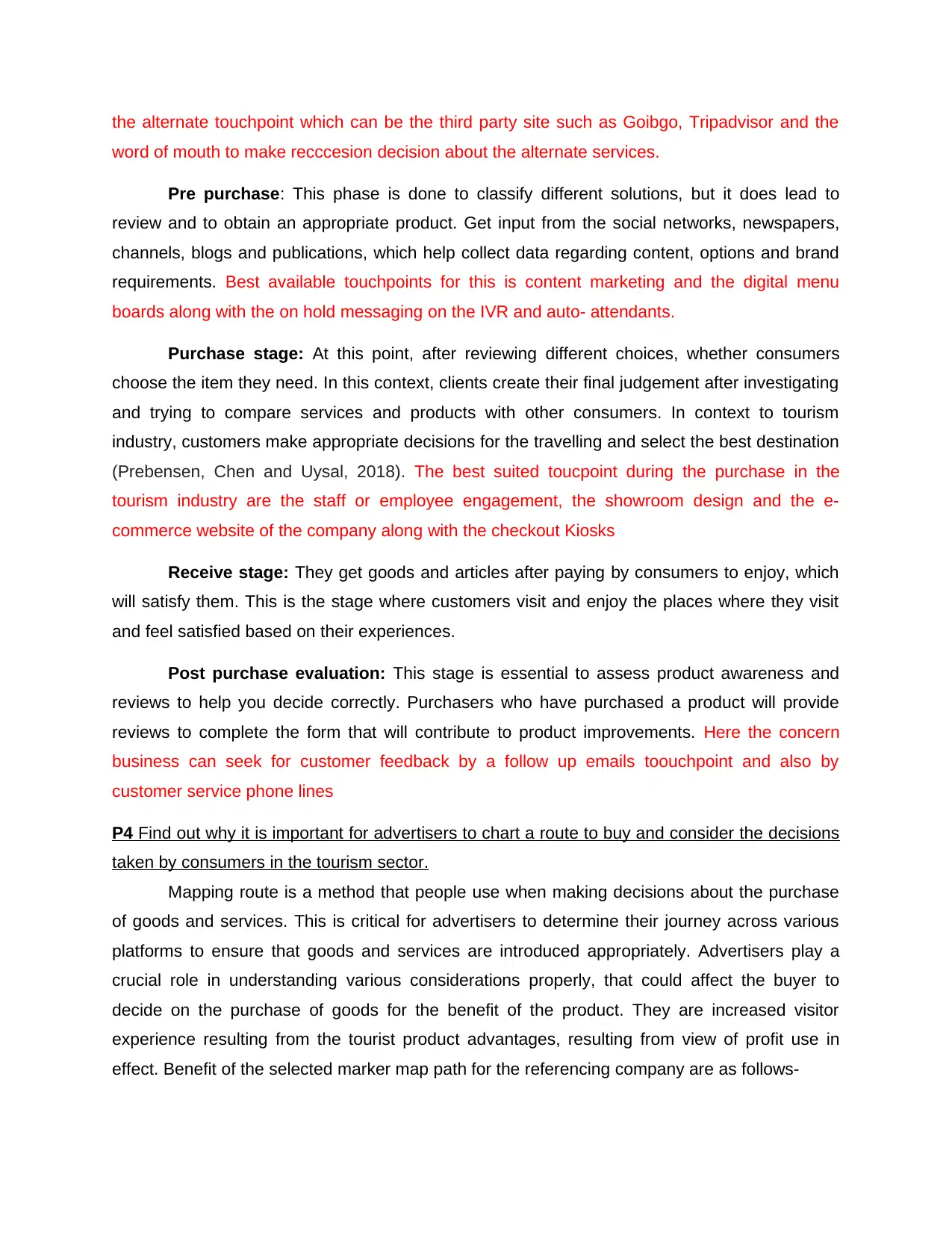
the alternate touchpoint which can be the third party site such as Goibgo, Tripadvisor and the
word of mouth to make recccesion decision about the alternate services.
Pre purchase: This phase is done to classify different solutions, but it does lead to
review and to obtain an appropriate product. Get input from the social networks, newspapers,
channels, blogs and publications, which help collect data regarding content, options and brand
requirements. Best available touchpoints for this is content marketing and the digital menu
boards along with the on hold messaging on the IVR and auto- attendants.
Purchase stage: At this point, after reviewing different choices, whether consumers
choose the item they need. In this context, clients create their final judgement after investigating
and trying to compare services and products with other consumers. In context to tourism
industry, customers make appropriate decisions for the travelling and select the best destination
(Prebensen, Chen and Uysal, 2018). The best suited toucpoint during the purchase in the
tourism industry are the staff or employee engagement, the showroom design and the e-
commerce website of the company along with the checkout Kiosks
Receive stage: They get goods and articles after paying by consumers to enjoy, which
will satisfy them. This is the stage where customers visit and enjoy the places where they visit
and feel satisfied based on their experiences.
Post purchase evaluation: This stage is essential to assess product awareness and
reviews to help you decide correctly. Purchasers who have purchased a product will provide
reviews to complete the form that will contribute to product improvements. Here the concern
business can seek for customer feedback by a follow up emails toouchpoint and also by
customer service phone lines
P4 Find out why it is important for advertisers to chart a route to buy and consider the decisions
taken by consumers in the tourism sector.
Mapping route is a method that people use when making decisions about the purchase
of goods and services. This is critical for advertisers to determine their journey across various
platforms to ensure that goods and services are introduced appropriately. Advertisers play a
crucial role in understanding various considerations properly, that could affect the buyer to
decide on the purchase of goods for the benefit of the product. They are increased visitor
experience resulting from the tourist product advantages, resulting from view of profit use in
effect. Benefit of the selected marker map path for the referencing company are as follows-
word of mouth to make recccesion decision about the alternate services.
Pre purchase: This phase is done to classify different solutions, but it does lead to
review and to obtain an appropriate product. Get input from the social networks, newspapers,
channels, blogs and publications, which help collect data regarding content, options and brand
requirements. Best available touchpoints for this is content marketing and the digital menu
boards along with the on hold messaging on the IVR and auto- attendants.
Purchase stage: At this point, after reviewing different choices, whether consumers
choose the item they need. In this context, clients create their final judgement after investigating
and trying to compare services and products with other consumers. In context to tourism
industry, customers make appropriate decisions for the travelling and select the best destination
(Prebensen, Chen and Uysal, 2018). The best suited toucpoint during the purchase in the
tourism industry are the staff or employee engagement, the showroom design and the e-
commerce website of the company along with the checkout Kiosks
Receive stage: They get goods and articles after paying by consumers to enjoy, which
will satisfy them. This is the stage where customers visit and enjoy the places where they visit
and feel satisfied based on their experiences.
Post purchase evaluation: This stage is essential to assess product awareness and
reviews to help you decide correctly. Purchasers who have purchased a product will provide
reviews to complete the form that will contribute to product improvements. Here the concern
business can seek for customer feedback by a follow up emails toouchpoint and also by
customer service phone lines
P4 Find out why it is important for advertisers to chart a route to buy and consider the decisions
taken by consumers in the tourism sector.
Mapping route is a method that people use when making decisions about the purchase
of goods and services. This is critical for advertisers to determine their journey across various
platforms to ensure that goods and services are introduced appropriately. Advertisers play a
crucial role in understanding various considerations properly, that could affect the buyer to
decide on the purchase of goods for the benefit of the product. They are increased visitor
experience resulting from the tourist product advantages, resulting from view of profit use in
effect. Benefit of the selected marker map path for the referencing company are as follows-
⊘ This is a preview!⊘
Do you want full access?
Subscribe today to unlock all pages.

Trusted by 1+ million students worldwide
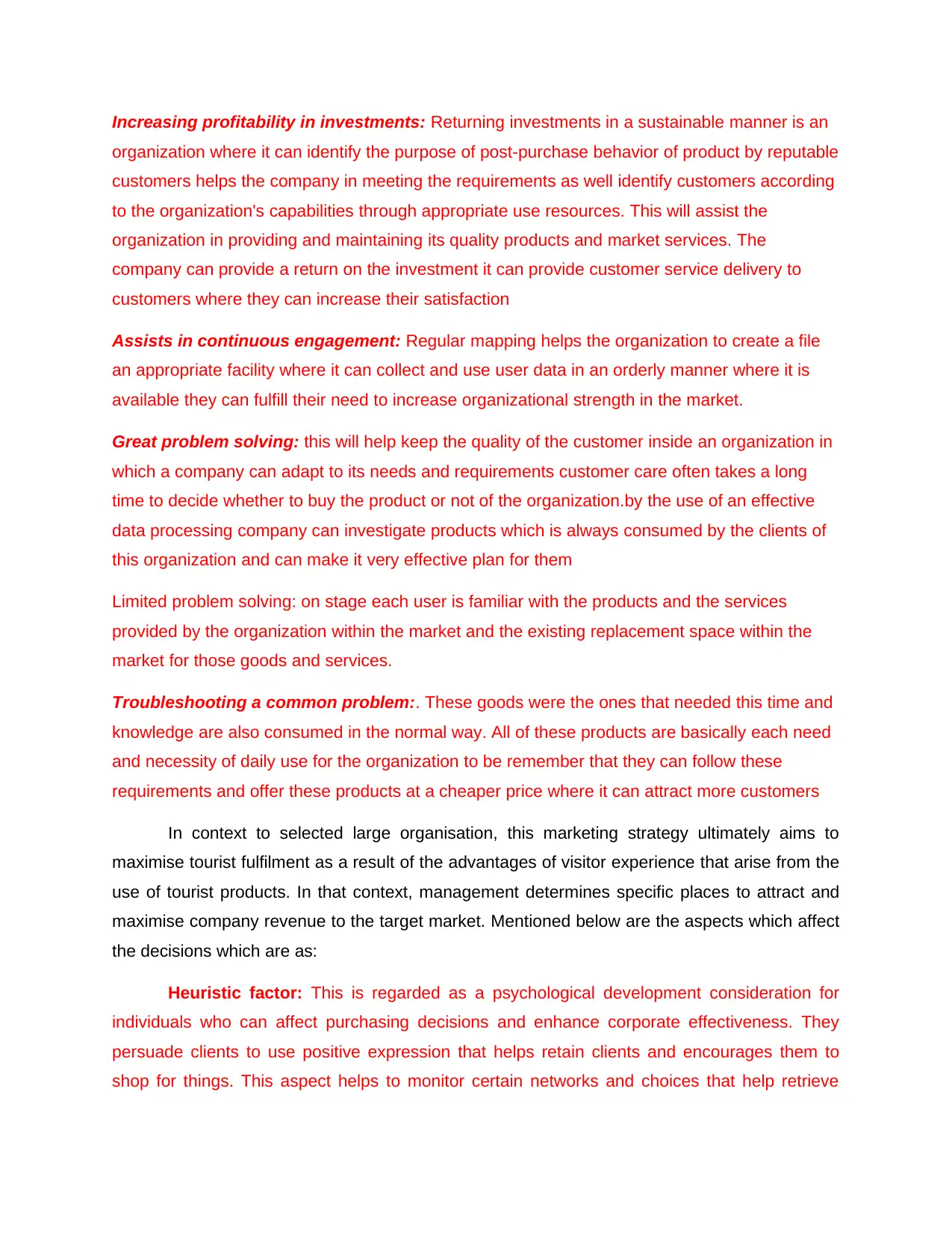
Increasing profitability in investments: Returning investments in a sustainable manner is an
organization where it can identify the purpose of post-purchase behavior of product by reputable
customers helps the company in meeting the requirements as well identify customers according
to the organization's capabilities through appropriate use resources. This will assist the
organization in providing and maintaining its quality products and market services. The
company can provide a return on the investment it can provide customer service delivery to
customers where they can increase their satisfaction
Assists in continuous engagement: Regular mapping helps the organization to create a file
an appropriate facility where it can collect and use user data in an orderly manner where it is
available they can fulfill their need to increase organizational strength in the market.
Great problem solving: this will help keep the quality of the customer inside an organization in
which a company can adapt to its needs and requirements customer care often takes a long
time to decide whether to buy the product or not of the organization.by the use of an effective
data processing company can investigate products which is always consumed by the clients of
this organization and can make it very effective plan for them
Limited problem solving: on stage each user is familiar with the products and the services
provided by the organization within the market and the existing replacement space within the
market for those goods and services.
Troubleshooting a common problem:. These goods were the ones that needed this time and
knowledge are also consumed in the normal way. All of these products are basically each need
and necessity of daily use for the organization to be remember that they can follow these
requirements and offer these products at a cheaper price where it can attract more customers
In context to selected large organisation, this marketing strategy ultimately aims to
maximise tourist fulfilment as a result of the advantages of visitor experience that arise from the
use of tourist products. In that context, management determines specific places to attract and
maximise company revenue to the target market. Mentioned below are the aspects which affect
the decisions which are as:
Heuristic factor: This is regarded as a psychological development consideration for
individuals who can affect purchasing decisions and enhance corporate effectiveness. They
persuade clients to use positive expression that helps retain clients and encourages them to
shop for things. This aspect helps to monitor certain networks and choices that help retrieve
organization where it can identify the purpose of post-purchase behavior of product by reputable
customers helps the company in meeting the requirements as well identify customers according
to the organization's capabilities through appropriate use resources. This will assist the
organization in providing and maintaining its quality products and market services. The
company can provide a return on the investment it can provide customer service delivery to
customers where they can increase their satisfaction
Assists in continuous engagement: Regular mapping helps the organization to create a file
an appropriate facility where it can collect and use user data in an orderly manner where it is
available they can fulfill their need to increase organizational strength in the market.
Great problem solving: this will help keep the quality of the customer inside an organization in
which a company can adapt to its needs and requirements customer care often takes a long
time to decide whether to buy the product or not of the organization.by the use of an effective
data processing company can investigate products which is always consumed by the clients of
this organization and can make it very effective plan for them
Limited problem solving: on stage each user is familiar with the products and the services
provided by the organization within the market and the existing replacement space within the
market for those goods and services.
Troubleshooting a common problem:. These goods were the ones that needed this time and
knowledge are also consumed in the normal way. All of these products are basically each need
and necessity of daily use for the organization to be remember that they can follow these
requirements and offer these products at a cheaper price where it can attract more customers
In context to selected large organisation, this marketing strategy ultimately aims to
maximise tourist fulfilment as a result of the advantages of visitor experience that arise from the
use of tourist products. In that context, management determines specific places to attract and
maximise company revenue to the target market. Mentioned below are the aspects which affect
the decisions which are as:
Heuristic factor: This is regarded as a psychological development consideration for
individuals who can affect purchasing decisions and enhance corporate effectiveness. They
persuade clients to use positive expression that helps retain clients and encourages them to
shop for things. This aspect helps to monitor certain networks and choices that help retrieve
Paraphrase This Document
Need a fresh take? Get an instant paraphrase of this document with our AI Paraphraser
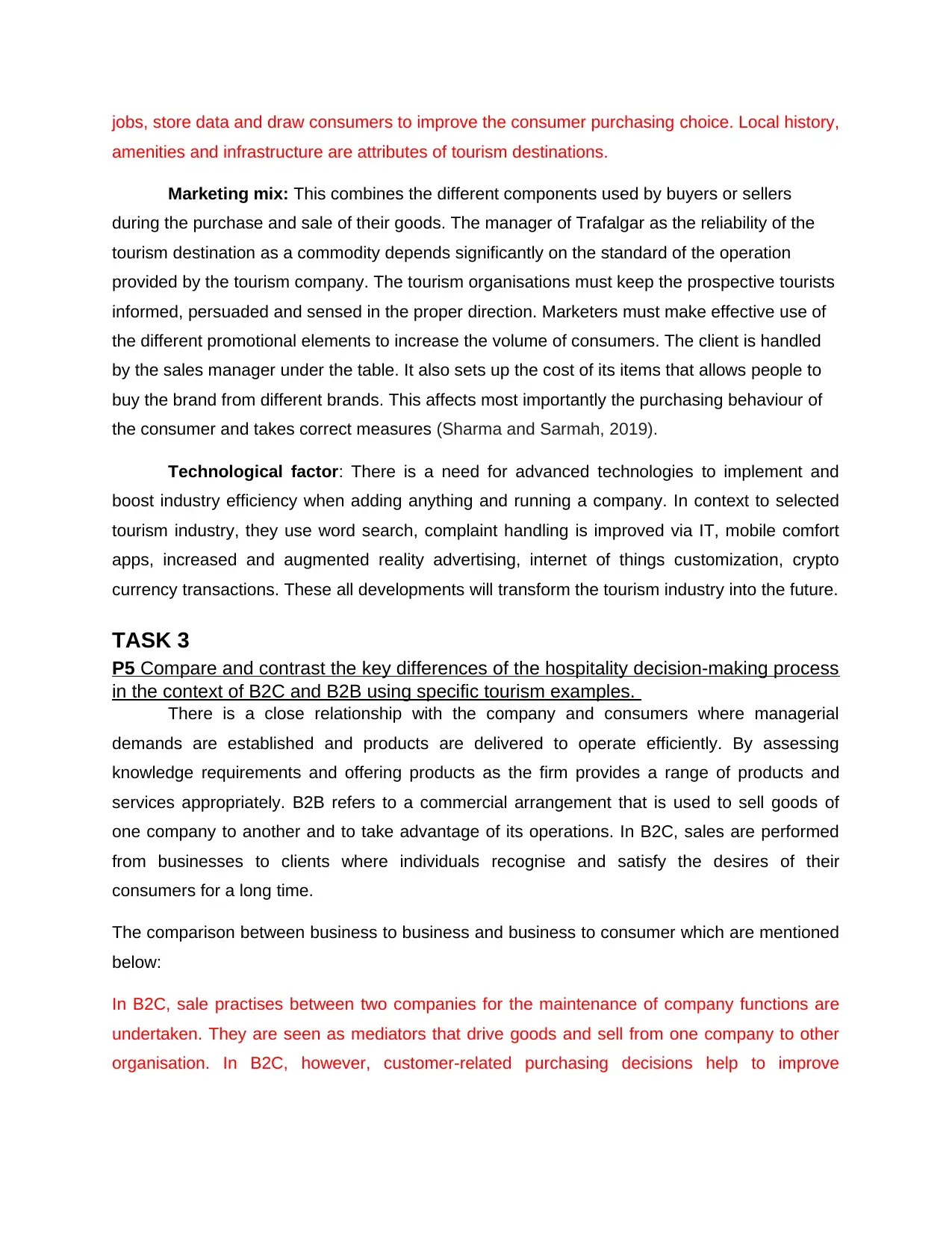
jobs, store data and draw consumers to improve the consumer purchasing choice. Local history,
amenities and infrastructure are attributes of tourism destinations.
Marketing mix: This combines the different components used by buyers or sellers
during the purchase and sale of their goods. The manager of Trafalgar as the reliability of the
tourism destination as a commodity depends significantly on the standard of the operation
provided by the tourism company. The tourism organisations must keep the prospective tourists
informed, persuaded and sensed in the proper direction. Marketers must make effective use of
the different promotional elements to increase the volume of consumers. The client is handled
by the sales manager under the table. It also sets up the cost of its items that allows people to
buy the brand from different brands. This affects most importantly the purchasing behaviour of
the consumer and takes correct measures (Sharma and Sarmah, 2019).
Technological factor: There is a need for advanced technologies to implement and
boost industry efficiency when adding anything and running a company. In context to selected
tourism industry, they use word search, complaint handling is improved via IT, mobile comfort
apps, increased and augmented reality advertising, internet of things customization, crypto
currency transactions. These all developments will transform the tourism industry into the future.
TASK 3
P5 Compare and contrast the key differences of the hospitality decision-making process
in the context of B2C and B2B using specific tourism examples.
There is a close relationship with the company and consumers where managerial
demands are established and products are delivered to operate efficiently. By assessing
knowledge requirements and offering products as the firm provides a range of products and
services appropriately. B2B refers to a commercial arrangement that is used to sell goods of
one company to another and to take advantage of its operations. In B2C, sales are performed
from businesses to clients where individuals recognise and satisfy the desires of their
consumers for a long time.
The comparison between business to business and business to consumer which are mentioned
below:
In B2C, sale practises between two companies for the maintenance of company functions are
undertaken. They are seen as mediators that drive goods and sell from one company to other
organisation. In B2C, however, customer-related purchasing decisions help to improve
amenities and infrastructure are attributes of tourism destinations.
Marketing mix: This combines the different components used by buyers or sellers
during the purchase and sale of their goods. The manager of Trafalgar as the reliability of the
tourism destination as a commodity depends significantly on the standard of the operation
provided by the tourism company. The tourism organisations must keep the prospective tourists
informed, persuaded and sensed in the proper direction. Marketers must make effective use of
the different promotional elements to increase the volume of consumers. The client is handled
by the sales manager under the table. It also sets up the cost of its items that allows people to
buy the brand from different brands. This affects most importantly the purchasing behaviour of
the consumer and takes correct measures (Sharma and Sarmah, 2019).
Technological factor: There is a need for advanced technologies to implement and
boost industry efficiency when adding anything and running a company. In context to selected
tourism industry, they use word search, complaint handling is improved via IT, mobile comfort
apps, increased and augmented reality advertising, internet of things customization, crypto
currency transactions. These all developments will transform the tourism industry into the future.
TASK 3
P5 Compare and contrast the key differences of the hospitality decision-making process
in the context of B2C and B2B using specific tourism examples.
There is a close relationship with the company and consumers where managerial
demands are established and products are delivered to operate efficiently. By assessing
knowledge requirements and offering products as the firm provides a range of products and
services appropriately. B2B refers to a commercial arrangement that is used to sell goods of
one company to another and to take advantage of its operations. In B2C, sales are performed
from businesses to clients where individuals recognise and satisfy the desires of their
consumers for a long time.
The comparison between business to business and business to consumer which are mentioned
below:
In B2C, sale practises between two companies for the maintenance of company functions are
undertaken. They are seen as mediators that drive goods and sell from one company to other
organisation. In B2C, however, customer-related purchasing decisions help to improve
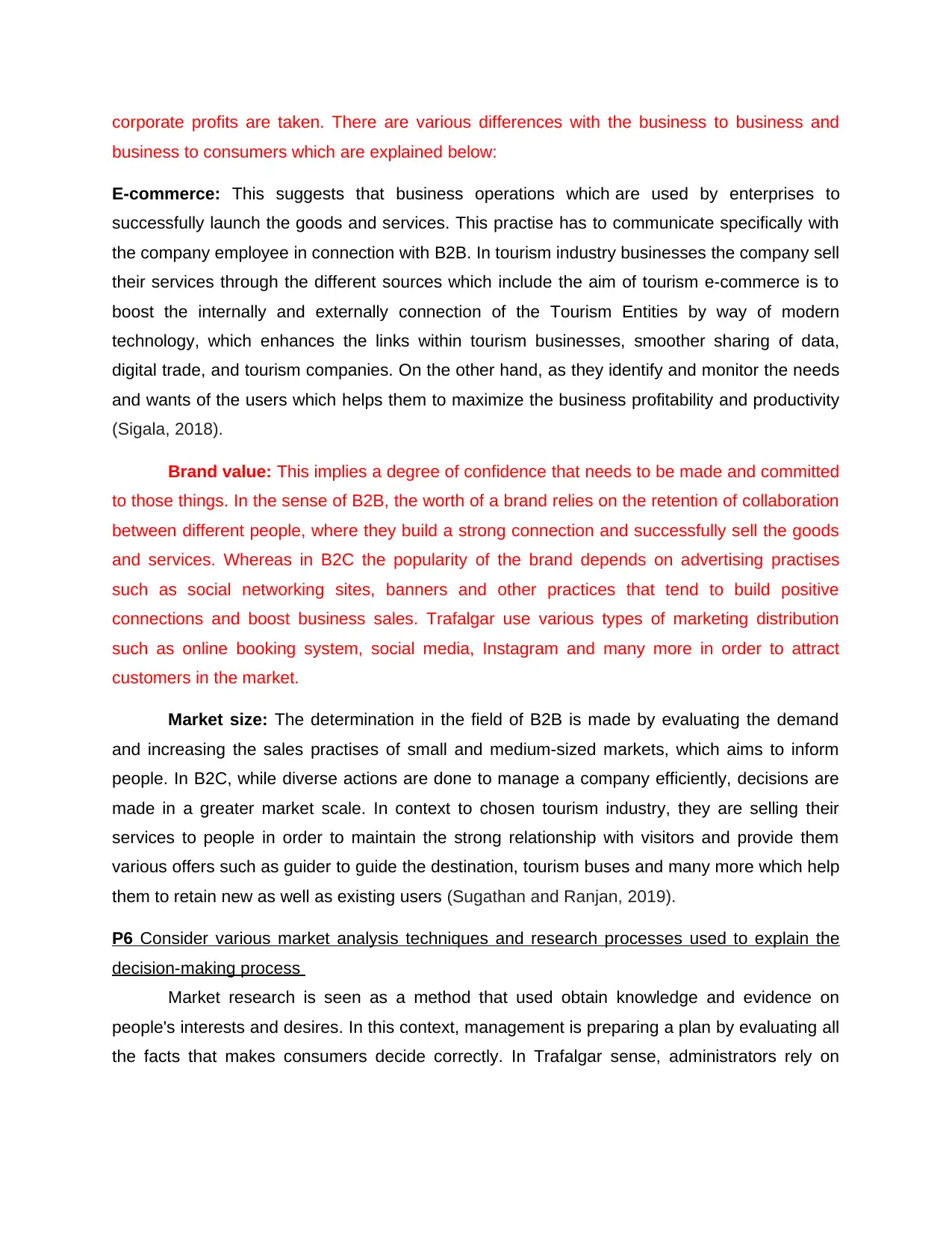
corporate profits are taken. There are various differences with the business to business and
business to consumers which are explained below:
E-commerce: This suggests that business operations which are used by enterprises to
successfully launch the goods and services. This practise has to communicate specifically with
the company employee in connection with B2B. In tourism industry businesses the company sell
their services through the different sources which include the aim of tourism e-commerce is to
boost the internally and externally connection of the Tourism Entities by way of modern
technology, which enhances the links within tourism businesses, smoother sharing of data,
digital trade, and tourism companies. On the other hand, as they identify and monitor the needs
and wants of the users which helps them to maximize the business profitability and productivity
(Sigala, 2018).
Brand value: This implies a degree of confidence that needs to be made and committed
to those things. In the sense of B2B, the worth of a brand relies on the retention of collaboration
between different people, where they build a strong connection and successfully sell the goods
and services. Whereas in B2C the popularity of the brand depends on advertising practises
such as social networking sites, banners and other practices that tend to build positive
connections and boost business sales. Trafalgar use various types of marketing distribution
such as online booking system, social media, Instagram and many more in order to attract
customers in the market.
Market size: The determination in the field of B2B is made by evaluating the demand
and increasing the sales practises of small and medium-sized markets, which aims to inform
people. In B2C, while diverse actions are done to manage a company efficiently, decisions are
made in a greater market scale. In context to chosen tourism industry, they are selling their
services to people in order to maintain the strong relationship with visitors and provide them
various offers such as guider to guide the destination, tourism buses and many more which help
them to retain new as well as existing users (Sugathan and Ranjan, 2019).
P6 Consider various market analysis techniques and research processes used to explain the
decision-making process
Market research is seen as a method that used obtain knowledge and evidence on
people's interests and desires. In this context, management is preparing a plan by evaluating all
the facts that makes consumers decide correctly. In Trafalgar sense, administrators rely on
business to consumers which are explained below:
E-commerce: This suggests that business operations which are used by enterprises to
successfully launch the goods and services. This practise has to communicate specifically with
the company employee in connection with B2B. In tourism industry businesses the company sell
their services through the different sources which include the aim of tourism e-commerce is to
boost the internally and externally connection of the Tourism Entities by way of modern
technology, which enhances the links within tourism businesses, smoother sharing of data,
digital trade, and tourism companies. On the other hand, as they identify and monitor the needs
and wants of the users which helps them to maximize the business profitability and productivity
(Sigala, 2018).
Brand value: This implies a degree of confidence that needs to be made and committed
to those things. In the sense of B2B, the worth of a brand relies on the retention of collaboration
between different people, where they build a strong connection and successfully sell the goods
and services. Whereas in B2C the popularity of the brand depends on advertising practises
such as social networking sites, banners and other practices that tend to build positive
connections and boost business sales. Trafalgar use various types of marketing distribution
such as online booking system, social media, Instagram and many more in order to attract
customers in the market.
Market size: The determination in the field of B2B is made by evaluating the demand
and increasing the sales practises of small and medium-sized markets, which aims to inform
people. In B2C, while diverse actions are done to manage a company efficiently, decisions are
made in a greater market scale. In context to chosen tourism industry, they are selling their
services to people in order to maintain the strong relationship with visitors and provide them
various offers such as guider to guide the destination, tourism buses and many more which help
them to retain new as well as existing users (Sugathan and Ranjan, 2019).
P6 Consider various market analysis techniques and research processes used to explain the
decision-making process
Market research is seen as a method that used obtain knowledge and evidence on
people's interests and desires. In this context, management is preparing a plan by evaluating all
the facts that makes consumers decide correctly. In Trafalgar sense, administrators rely on
⊘ This is a preview!⊘
Do you want full access?
Subscribe today to unlock all pages.

Trusted by 1+ million students worldwide
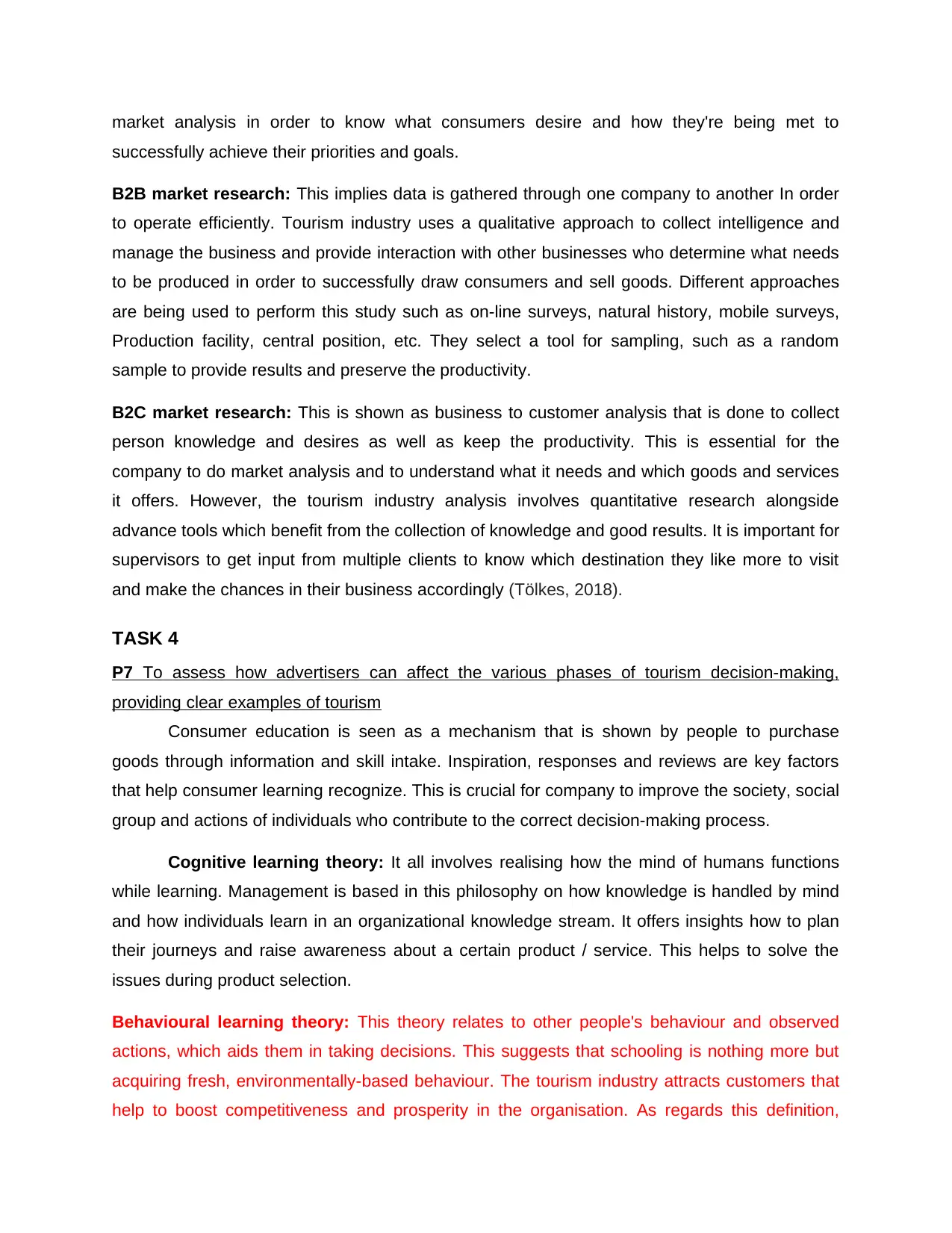
market analysis in order to know what consumers desire and how they're being met to
successfully achieve their priorities and goals.
B2B market research: This implies data is gathered through one company to another In order
to operate efficiently. Tourism industry uses a qualitative approach to collect intelligence and
manage the business and provide interaction with other businesses who determine what needs
to be produced in order to successfully draw consumers and sell goods. Different approaches
are being used to perform this study such as on-line surveys, natural history, mobile surveys,
Production facility, central position, etc. They select a tool for sampling, such as a random
sample to provide results and preserve the productivity.
B2C market research: This is shown as business to customer analysis that is done to collect
person knowledge and desires as well as keep the productivity. This is essential for the
company to do market analysis and to understand what it needs and which goods and services
it offers. However, the tourism industry analysis involves quantitative research alongside
advance tools which benefit from the collection of knowledge and good results. It is important for
supervisors to get input from multiple clients to know which destination they like more to visit
and make the chances in their business accordingly (Tölkes, 2018).
TASK 4
P7 To assess how advertisers can affect the various phases of tourism decision-making,
providing clear examples of tourism
Consumer education is seen as a mechanism that is shown by people to purchase
goods through information and skill intake. Inspiration, responses and reviews are key factors
that help consumer learning recognize. This is crucial for company to improve the society, social
group and actions of individuals who contribute to the correct decision-making process.
Cognitive learning theory: It all involves realising how the mind of humans functions
while learning. Management is based in this philosophy on how knowledge is handled by mind
and how individuals learn in an organizational knowledge stream. It offers insights how to plan
their journeys and raise awareness about a certain product / service. This helps to solve the
issues during product selection.
Behavioural learning theory: This theory relates to other people's behaviour and observed
actions, which aids them in taking decisions. This suggests that schooling is nothing more but
acquiring fresh, environmentally-based behaviour. The tourism industry attracts customers that
help to boost competitiveness and prosperity in the organisation. As regards this definition,
successfully achieve their priorities and goals.
B2B market research: This implies data is gathered through one company to another In order
to operate efficiently. Tourism industry uses a qualitative approach to collect intelligence and
manage the business and provide interaction with other businesses who determine what needs
to be produced in order to successfully draw consumers and sell goods. Different approaches
are being used to perform this study such as on-line surveys, natural history, mobile surveys,
Production facility, central position, etc. They select a tool for sampling, such as a random
sample to provide results and preserve the productivity.
B2C market research: This is shown as business to customer analysis that is done to collect
person knowledge and desires as well as keep the productivity. This is essential for the
company to do market analysis and to understand what it needs and which goods and services
it offers. However, the tourism industry analysis involves quantitative research alongside
advance tools which benefit from the collection of knowledge and good results. It is important for
supervisors to get input from multiple clients to know which destination they like more to visit
and make the chances in their business accordingly (Tölkes, 2018).
TASK 4
P7 To assess how advertisers can affect the various phases of tourism decision-making,
providing clear examples of tourism
Consumer education is seen as a mechanism that is shown by people to purchase
goods through information and skill intake. Inspiration, responses and reviews are key factors
that help consumer learning recognize. This is crucial for company to improve the society, social
group and actions of individuals who contribute to the correct decision-making process.
Cognitive learning theory: It all involves realising how the mind of humans functions
while learning. Management is based in this philosophy on how knowledge is handled by mind
and how individuals learn in an organizational knowledge stream. It offers insights how to plan
their journeys and raise awareness about a certain product / service. This helps to solve the
issues during product selection.
Behavioural learning theory: This theory relates to other people's behaviour and observed
actions, which aids them in taking decisions. This suggests that schooling is nothing more but
acquiring fresh, environmentally-based behaviour. The tourism industry attracts customers that
help to boost competitiveness and prosperity in the organisation. As regards this definition,
Paraphrase This Document
Need a fresh take? Get an instant paraphrase of this document with our AI Paraphraser
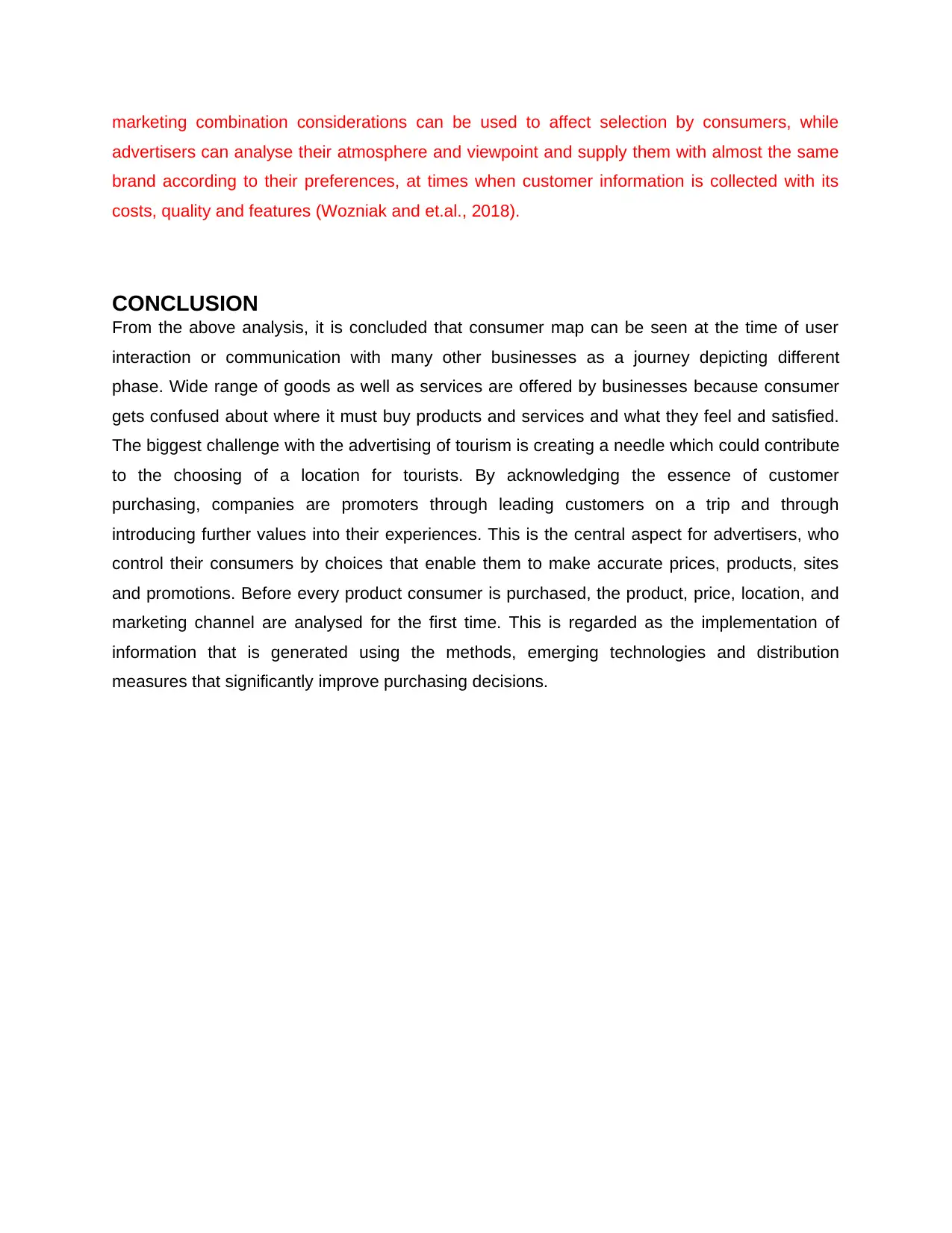
marketing combination considerations can be used to affect selection by consumers, while
advertisers can analyse their atmosphere and viewpoint and supply them with almost the same
brand according to their preferences, at times when customer information is collected with its
costs, quality and features (Wozniak and et.al., 2018).
CONCLUSION
From the above analysis, it is concluded that consumer map can be seen at the time of user
interaction or communication with many other businesses as a journey depicting different
phase. Wide range of goods as well as services are offered by businesses because consumer
gets confused about where it must buy products and services and what they feel and satisfied.
The biggest challenge with the advertising of tourism is creating a needle which could contribute
to the choosing of a location for tourists. By acknowledging the essence of customer
purchasing, companies are promoters through leading customers on a trip and through
introducing further values into their experiences. This is the central aspect for advertisers, who
control their consumers by choices that enable them to make accurate prices, products, sites
and promotions. Before every product consumer is purchased, the product, price, location, and
marketing channel are analysed for the first time. This is regarded as the implementation of
information that is generated using the methods, emerging technologies and distribution
measures that significantly improve purchasing decisions.
advertisers can analyse their atmosphere and viewpoint and supply them with almost the same
brand according to their preferences, at times when customer information is collected with its
costs, quality and features (Wozniak and et.al., 2018).
CONCLUSION
From the above analysis, it is concluded that consumer map can be seen at the time of user
interaction or communication with many other businesses as a journey depicting different
phase. Wide range of goods as well as services are offered by businesses because consumer
gets confused about where it must buy products and services and what they feel and satisfied.
The biggest challenge with the advertising of tourism is creating a needle which could contribute
to the choosing of a location for tourists. By acknowledging the essence of customer
purchasing, companies are promoters through leading customers on a trip and through
introducing further values into their experiences. This is the central aspect for advertisers, who
control their consumers by choices that enable them to make accurate prices, products, sites
and promotions. Before every product consumer is purchased, the product, price, location, and
marketing channel are analysed for the first time. This is regarded as the implementation of
information that is generated using the methods, emerging technologies and distribution
measures that significantly improve purchasing decisions.
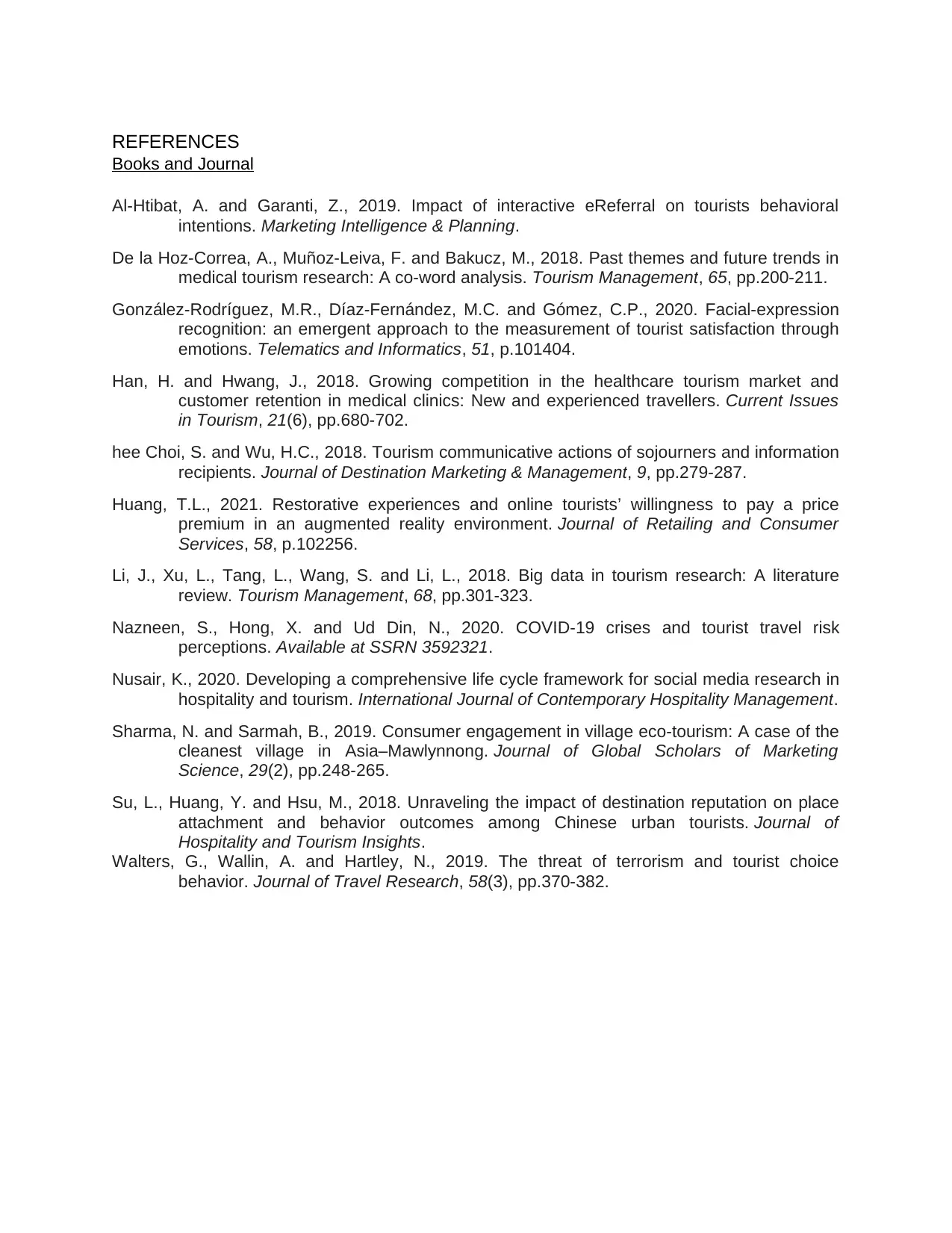
REFERENCES
Books and Journal
Al-Htibat, A. and Garanti, Z., 2019. Impact of interactive eReferral on tourists behavioral
intentions. Marketing Intelligence & Planning.
De la Hoz-Correa, A., Muñoz-Leiva, F. and Bakucz, M., 2018. Past themes and future trends in
medical tourism research: A co-word analysis. Tourism Management, 65, pp.200-211.
González-Rodríguez, M.R., Díaz-Fernández, M.C. and Gómez, C.P., 2020. Facial-expression
recognition: an emergent approach to the measurement of tourist satisfaction through
emotions. Telematics and Informatics, 51, p.101404.
Han, H. and Hwang, J., 2018. Growing competition in the healthcare tourism market and
customer retention in medical clinics: New and experienced travellers. Current Issues
in Tourism, 21(6), pp.680-702.
hee Choi, S. and Wu, H.C., 2018. Tourism communicative actions of sojourners and information
recipients. Journal of Destination Marketing & Management, 9, pp.279-287.
Huang, T.L., 2021. Restorative experiences and online tourists’ willingness to pay a price
premium in an augmented reality environment. Journal of Retailing and Consumer
Services, 58, p.102256.
Li, J., Xu, L., Tang, L., Wang, S. and Li, L., 2018. Big data in tourism research: A literature
review. Tourism Management, 68, pp.301-323.
Nazneen, S., Hong, X. and Ud Din, N., 2020. COVID-19 crises and tourist travel risk
perceptions. Available at SSRN 3592321.
Nusair, K., 2020. Developing a comprehensive life cycle framework for social media research in
hospitality and tourism. International Journal of Contemporary Hospitality Management.
Sharma, N. and Sarmah, B., 2019. Consumer engagement in village eco-tourism: A case of the
cleanest village in Asia–Mawlynnong. Journal of Global Scholars of Marketing
Science, 29(2), pp.248-265.
Su, L., Huang, Y. and Hsu, M., 2018. Unraveling the impact of destination reputation on place
attachment and behavior outcomes among Chinese urban tourists. Journal of
Hospitality and Tourism Insights.
Walters, G., Wallin, A. and Hartley, N., 2019. The threat of terrorism and tourist choice
behavior. Journal of Travel Research, 58(3), pp.370-382.
Books and Journal
Al-Htibat, A. and Garanti, Z., 2019. Impact of interactive eReferral on tourists behavioral
intentions. Marketing Intelligence & Planning.
De la Hoz-Correa, A., Muñoz-Leiva, F. and Bakucz, M., 2018. Past themes and future trends in
medical tourism research: A co-word analysis. Tourism Management, 65, pp.200-211.
González-Rodríguez, M.R., Díaz-Fernández, M.C. and Gómez, C.P., 2020. Facial-expression
recognition: an emergent approach to the measurement of tourist satisfaction through
emotions. Telematics and Informatics, 51, p.101404.
Han, H. and Hwang, J., 2018. Growing competition in the healthcare tourism market and
customer retention in medical clinics: New and experienced travellers. Current Issues
in Tourism, 21(6), pp.680-702.
hee Choi, S. and Wu, H.C., 2018. Tourism communicative actions of sojourners and information
recipients. Journal of Destination Marketing & Management, 9, pp.279-287.
Huang, T.L., 2021. Restorative experiences and online tourists’ willingness to pay a price
premium in an augmented reality environment. Journal of Retailing and Consumer
Services, 58, p.102256.
Li, J., Xu, L., Tang, L., Wang, S. and Li, L., 2018. Big data in tourism research: A literature
review. Tourism Management, 68, pp.301-323.
Nazneen, S., Hong, X. and Ud Din, N., 2020. COVID-19 crises and tourist travel risk
perceptions. Available at SSRN 3592321.
Nusair, K., 2020. Developing a comprehensive life cycle framework for social media research in
hospitality and tourism. International Journal of Contemporary Hospitality Management.
Sharma, N. and Sarmah, B., 2019. Consumer engagement in village eco-tourism: A case of the
cleanest village in Asia–Mawlynnong. Journal of Global Scholars of Marketing
Science, 29(2), pp.248-265.
Su, L., Huang, Y. and Hsu, M., 2018. Unraveling the impact of destination reputation on place
attachment and behavior outcomes among Chinese urban tourists. Journal of
Hospitality and Tourism Insights.
Walters, G., Wallin, A. and Hartley, N., 2019. The threat of terrorism and tourist choice
behavior. Journal of Travel Research, 58(3), pp.370-382.
⊘ This is a preview!⊘
Do you want full access?
Subscribe today to unlock all pages.

Trusted by 1+ million students worldwide
1 out of 12
Related Documents
Your All-in-One AI-Powered Toolkit for Academic Success.
+13062052269
info@desklib.com
Available 24*7 on WhatsApp / Email
![[object Object]](/_next/static/media/star-bottom.7253800d.svg)
Unlock your academic potential
Copyright © 2020–2025 A2Z Services. All Rights Reserved. Developed and managed by ZUCOL.




